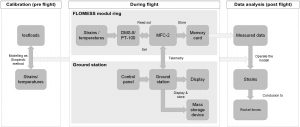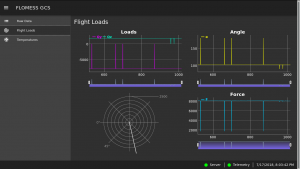The Software is the link between Hardware and Mechanics. With the program code developed by us, it is possible to transfer the theory of our mechanical models to our physically available hardware. The application is manifold and is divided into three phases over the duration of the entire project.

Tasks
During calibration, the main focus of the programming activities is to obtain usable data from the measurements. The basis for this is to receive data first – In this sense the communication between the used amplifier modules and a PC must be guaranteed. The incoming data is then sorted and converted into a suitable format. In order to calculate the mechanical model according to the Skopinski method, the values of the applied loads are required in addition to the measured strains. The presentation of the results takes place in a constant dialogue with the Mechanics section.

Test results as diagramms
In the second phase, the flight phase, special software requirements apply. The REXUS rocket with its service module has its own telemetry, which can be used by our experiment module. Before the start, the amplifier modules are initialized and configured via the uplink from our Ground Controll Station. Strains are measured during the flight. Our flight processor, the MFC-2, ensures that the data is saved on an SD card. Furthermore, some of the data is sent via telemetry to the Ground Control Station for live analysis. To do this, first the processor have to make a selection which data should be sent. This data is then packed in a suitable data format and sent via an interface to the Rexus Service Module. Since the rocket has a bandwidth limit, the software team creates a data budget. The data is processed in real time in the own Ground Controll Station and displayed in graphs. Two programs are used for this: The data packets are received in a server program and the existing loads are calculated with the calibration matrix of the calibration phase. Secondly, a Web frontend is used, in which the measured values are displayed graphically.

Ground Control Station with realtime analysis
During post-flight analysis, the Mechanics section works closely with the Software to achieve an accurate analysis of the measurement. Above all, the temperature influence on the rocket structure must also be taken into account.
Member
Manuel is responsible for the Software section. His main tasks are the communication with the other sections and the operation of the software during calibration. He can benefit from his experience from his bachelor’s degree in aerospace technology. He is supported in programming by Simon, Nico and Martin. Through their studies of technical computer science they have the necessary expertise in this field. When programming the software, they usually work as a team to solve problems that occur together.